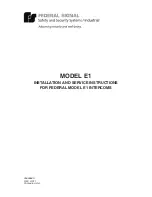
66251750-EN - V1.0 - 05/06/17
51
4000 Series Vandal Resistant Digital GSM Audio Intercom with Proximity
4000 Series Vandal Resistant Digital GSM - Technical Manual
SET CALL TIME (SPT)
The call time is the maximum time in seconds that a call can last before the GSM panel automatically clears the call down. The time
can be from 1 second up to 255 seconds and begins from when the call is made from the panel. The default time is 40 seconds. The
following messages are used to set/check the maximum call time (also refer to notes on page 42).
1111SPTnnn
Store the call time nnn seconds, where nnn is the time in seconds.
1111SPTnnn?
Store the call time nnn seconds, where nnn is the time in seconds. Also send a confirmation
text back to the sender.
1111SPT?
Query the current stored call time. A text message will be sent back to the sender showing
the stored time.
SET RELAY TIME (RLT)
The relay time can be set from 001 – 255 seconds or latching. To set the relay time for latched mode set the relay time to 000. In latch
mode the relay will stay energised until the command is sent again (also refer to notes on page 43).
1111RLTnnn
Store the relay time nnn = time in seconds (e.g. nnn = 005, time = 5 seconds).
1111RLTnnn?
Store the relay time nnn = time in seconds. Also send a confirmation text back to the
sender.
1111RLT?
Query the current stored relay time. A text message will be sent back to the sender
showing the stored relay time.
SET AUXILIARY OUTPUT AO TIME (A1T, FOR A1M MODE = 001 OR 002 ONLY)
The auxiliary output AO time can be set from 001 - 255 seconds or latching. To set the AO output time for latched mode set the
auxiliary time to 000. In latch mode the AO output will stay triggered until the relevant command is sent again to unlatch the output
(e.g. sending text message
1111A1O
to the digital GSM) or during a call by pressing 6 on the telephone to reset the AO output. The
latching mode option is only available when the AO output mode,
A1M
, is set to mode 001. Please refer to the
A1M
modes below
for more details (also refer to notes on page 43).
1111A1Tnnn
Store the AO time nnn = time in seconds (e.g. nnn = 005, time = 5 seconds).
1111A1Tnnn?
Store the AO time nnn = time in seconds. Also send a confirmation text back to the sender.
1111A1T?
Query the current stored AO time. A text message will be sent back to the sender showing
the stored AO time.
SET AUXILIARY OUTPUT AO MODE (A1M, MODES 000 - 002)
The auxiliary output AO has three modes that can be set (also see additional notes on page 39):
Call Activated: nnn = 000
AO output will activate when a call begins and deactivate when a call ends. See example on page 13.
User Activated: nnn = 001 (default mode)
To activate the AO output press 6 on the telephone during a call or sending the text message
1111A1O
to the digital GSM. The
auxiliary output can also be activated by triggering the auxiliary input AI. See example on page 13.
Call Activated (Timed): nnn = 002
AO output will activate when a call begins and deactivate when the auxiliary output time (
A1T
) expires. See example on page 14.
1111A1Mnnn
Store the AO mode nnn = 000 - 002 (see modes above).
1111A1Mnnn?
Store the AO mode nnn = 00n - 002 (see modes above). Also send a confirmation text
back to the sender.
1111A1M?
Query the current stored AO mode (see modes above). A text message will be sent back
to the sender showing the stored AO mode.
KEEP CONNECTION FACILITY (NOD)
In the event the digital GSM intercom panel is not used for long periods of time it could be possible that the network disconnects
it. To prevent this from happening it is possible to program a time period (from 001 – 365 days or disabled 000) to wait before the
digital GSM intercom makes a short call to refresh the connection to the network. This time period is reset after each call made on
the system and will only happen if the full time period elapses without any incoming or outgoing calls.
Programming via Text Message
















































